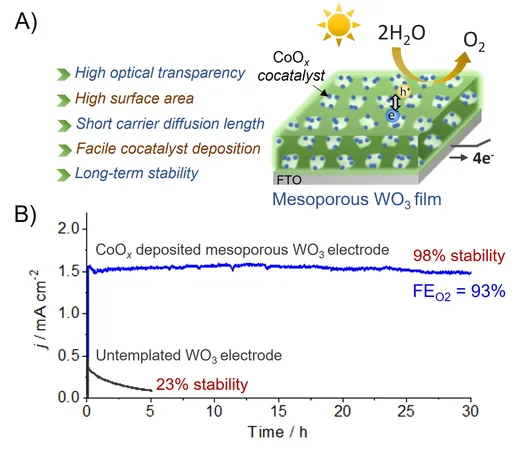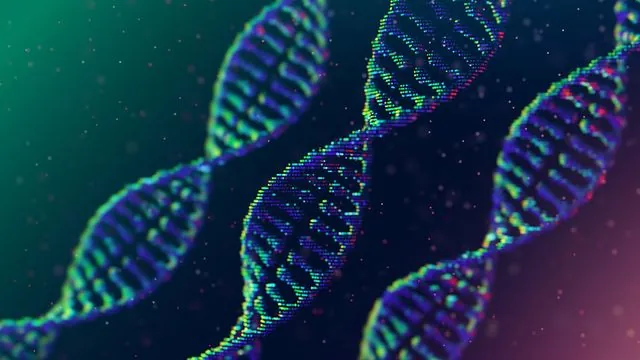
Game-Changer in Renewable Energy: Transparent WO₃ Film Boosts Solar Water Splitting Efficiency!
2025-09-05
Author: Yu
Revolutionizing Renewable Energy Materials
In an exciting advancement for renewable energy, scientists have unveiled a groundbreaking transparent, crystalline mesoporous tungsten trioxide (WO₃) film that dramatically enhances the efficiency and stability of solar-driven water splitting.
Unlocking Sustainable Energy
This innovative development holds great promise for accelerating the transition to sustainable solar-to-hydrogen technologies, a clean energy solution that could significantly impact global efforts towards decarbonization.
Harnessing Nature's Power
The new WO₃ film features a meticulously organized mesoporous structure with tailored crystal orientation, achieving unprecedented efficiency and durability in neutral pH conditions. This breakthrough provides a viable pathway for the creation of advanced photoelectrochemical (PEC) devices designed for sustainable hydrogen production.
Cutting-Edge Fabrication Technique
Crafted directly on a conductive glass substrate using a unique surfactant-template method combined with in-situ template-carbonization, this film boasts an intricate crystalline mesoporous network with ultrathin pore walls (~10 nm) and an impressive surface area of 124 m²/g.
A Step Ahead of Conventional Materials
According to lead author Dr. Debraj Chandra, the innovative synthesis method retains the uniquely organized structure of the WO₃ film, signaling a potential breakthrough for future crystalline mesoporous metal oxide films. The mesoporous WO₃ photoanode demonstrates phenomenal incident photon-to-current conversion efficiencies (IPCE) of 49% in acidic conditions and 41% in neutral pH, significantly outperforming traditional WO₃ films.
Boosting Performance with Co-Catalysts
The introduction of cobalt oxide (CoOx) nanoparticles has further amplified the performance of the WO₃ film, enhancing surface reactions and pushing the oxygen evolution rate constant to an impressive 5.7 x 10² s⁻¹.
Promising Durability and Efficiency
With a remarkable faradaic efficiency of 93% for oxygen evolution and exceptional durability—retaining 98% of its initial photocurrent after 30 hours of continuous operation—this mesoporous WO₃ electrode is set to transform the landscape of hydrogen production.
Beyond Technological Limits
The optical transparency of the material is a game-changer, enhancing its function as a front light-harvesting layer when paired with PEC devices. This allows for stacking multiple photoabsorbers to optimize efficiency across the solar spectrum.
Towards a Greener Future
According to corresponding author Dr. Masayuki Yagi, the high optical transparency and long-term stability of this mesoporous WO₃ electrode present a scalable strategy for tandem water-splitting devices, propelling renewable hydrogen production into a new era.
A Blueprint for Next-Gen Photoanodes
While hydrogen is a promising clean energy carrier, traditional photoactive materials often fall short in stability and efficiency. This innovative study lays the groundwork for the development of next-generation photoanodes that combine long-term stability, transparency, and high efficiency.
Expanding the Impact
The scalable fabrication strategy demonstrated here not only promises advancements in WO₃ but can also be adapted for other metal oxide semiconductors, amplifying its influence in the renewable energy sector.
Conclusion: A New Era in Hydrogen Production
This extraordinary innovation marks a significant step toward practical solar water-splitting systems capable of producing renewable hydrogen on a large scale, positioning us closer to a sustainable energy future.



 Brasil (PT)
Brasil (PT)
 Canada (EN)
Canada (EN)
 Chile (ES)
Chile (ES)
 Česko (CS)
Česko (CS)
 대한민국 (KO)
대한민국 (KO)
 España (ES)
España (ES)
 France (FR)
France (FR)
 Hong Kong (EN)
Hong Kong (EN)
 Italia (IT)
Italia (IT)
 日本 (JA)
日本 (JA)
 Magyarország (HU)
Magyarország (HU)
 Norge (NO)
Norge (NO)
 Polska (PL)
Polska (PL)
 Schweiz (DE)
Schweiz (DE)
 Singapore (EN)
Singapore (EN)
 Sverige (SV)
Sverige (SV)
 Suomi (FI)
Suomi (FI)
 Türkiye (TR)
Türkiye (TR)
 الإمارات العربية المتحدة (AR)
الإمارات العربية المتحدة (AR)